soziale stadt - bundestransferstelle
besonderem Entwicklungsbedarf - Soziale Stadt"
Leinefelde Südstadt
|
Martina Buhtz |
|||||||
Since 1999, Leinefelde-Südstadt has been a model area in the Federal/Länder programme "Socially Integrative City" and one of the seven programme communities in Thuringia. From the outset, a practice-oriented and cross-authority approach has been encouraged in Thuringia in implementing the programme. A crucial contribution has been made by the "Thuringia Socially Integrative City Working Party" set up under the overall control of the Thuringian Ministry of the Interior / Urban Development Promotion. Programme municipalities, state ministries (interior, economics, education and culture, social affairs), housing companies, and planning offices are represented on this body. At their regular meetings, members exchange experience on the course of the programme. A joint overview of support programmes amenable to integration has been an important aid to work for everyone involved in the process of finding suitable forms and possibilities for bundling investment and non-investment resources for district development. In Leinefelde-Südstadt this has been successful in many areas.
1. Nature of the Area 
Leinefelde lies amidst the charming Eichsfeld landscape in north-western Thuringia, almost at the geographical centre of Germany. The town has experienced many changes. Until the beginning of the 1960s, village structures dominated the life of the then 2,200 residents. The town grew to many times this size after a new economic structure had been developed between 1961 and 1989 under the "Eichsfeld Plan," bringing 6,000 jobs in the textile and cement industries and in potash mining.
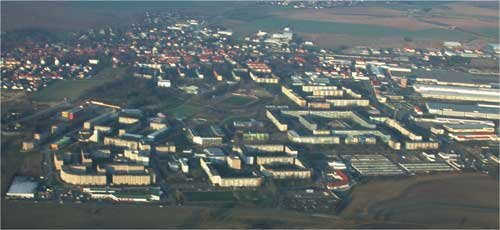 |
| The model area Leinefelde-Südstadt seen from the air (Source: Leinefelde Municipality) |
A new district was built in the immediate vicinity of the cotton mill with 4,850 dwellings in block and large-panel construction development: the present model area Südstadt. The population of Leinefelde grew in a short space of time from 2,300 to 16,000, of whom just under 90% lived in Südstadt.
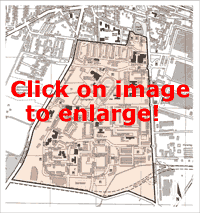 |
The boundaries of the model area Leinefelde-Südstadt (Source: Büro GRAS) |
Südstadt is a typical panel construction estate with five and six-storey residential buildings. Flats have standardised floor plans and are comparatively small by modern standards. Built primarily for young families, most flats have three, four, or five rooms. In 1995, the average occupancy rate was 2.4 persons per dwelling. The advantages of living in Südstadt, appreciated in particular by young families and single mothers (in 1995 8%) included the short distance between work and home and the adequate provision of day-care facilities and schools.
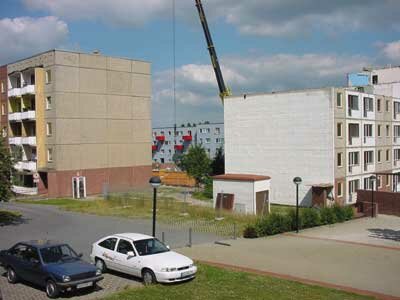 |
Changing Südstadt: population decline and vacant housing make demolition and down-scaling necessary; at the same time, the remaining housing stock is being upgraded and the dwelling surroundings remodelled. (Source: Weeber + Partner, Stuttgart) |
Even if it seems unlikely at first glance, Südstadt is not a homogeneous district. The last areas to be developed are more dense, of lower standard, and offer unattractive dwelling environs. These structural shortcomings and the monofunctionality of the area gave Südstadt the reputation of a "dormitory suburb" until well into the 1990s.
2. Main Problems and Development Potential 
One of the main problems is the economic monostructure and its consequences. When industrial production collapsed after 1990, the monostructure proved fatal for Südstadt. The economic structure as it had existed determined the employment and skills profile of residents. Over 90% of residents of employable age were blue and white-collar workers, mainly in the textile industry. Of the former 4,500 jobs in the cotton mill, only 450 were saved. Women, traditionally employed in this industry, were especially hard hit by unemployment. Despite intensive political efforts, these losses have not yet been compensated, although labour market promotion measures have placed some Leinefelders in work again. Others have become commuters to the neighbouring region Kassel-Göttingen.
Since 1994, the population of Leinefelde has declined through outmigration by some 500 annually. It is particularly problematic that most of those leaving are young. The biggest wave of departures was between 1994 and 1997. The climax was reached in 1996 and 1997 with an annual loss of 6%. In recent years, the trend has weakened. Demographic development has been affected not only by outmigration but also by a declining birth rate. In 2010, Leinefelde is expected to have only 8,000 residents left, about half the number in 1989. At this level the population is likely to stabilise.
Demography and Social Space
|
Südstadt |
Leinefelde |
|
|
Size |
113 ha |
700 ha |
|
Population |
7 302 |
11 227 |
|
Population decline (1995–2000) |
37 % |
25 % |
|
Average household size |
2.1 pers. |
2.4 pers. |
|
Number of dwellings |
4 766 |
6 215 |
|
Vacancy rate |
26.4 % |
20.4 % |
|
Housing benefit recipients |
n.a. |
n.a. |
|
Unemployment rate (1) |
n.a. |
15 % |
|
Social assistance recipients (1) |
n.a. |
2 % |
|
Foreign population (1) |
n.a. |
1.7 % |
|
Population under 18 |
20.2 % |
19.7 % |
|
Population 60 and older |
18.2 % |
18.4 % |
|
(1) No separate statistical records are kept for Südstadt. But since the greater part of the Leinefelde population lives there, the data from the town as a whole is to a large extent transferable to the model area. |
||
The local housing market is in a state of flux. The lack of demand owing to population decline has put the housing companies in a difficult position. Over 1,000 dwellings in Südstadt are no longer rented, the southern area being particularly badly hit.
The developments described have directly affected the social structure of Südstadt. Unemployment, income losses, and outmigration threaten social stability. Neighbourhoods have changed rapidly as residents have left and new people have arrived. Especially in the southern part of the model area, there is a concentration of social conflict potential. A spiral had been triggered, reinforced by inadequate possibilities for communication and social contacts. The image of Südstadt deteriorated markedly in the mid-1990s.
The residents of Südstadt are the area's most important potential. The declared objective is to keep them in the district and to involve them actively in its development. Many are well qualified and have close ties with Leinefelde. Numerous clubs, citizens' groups, and the churches are active in the neighbourhood and involved in community work.
Südstadt has a good social infrastructure, which has improved in recent years and adapted to changed needs. Schools and day nurseries have been rehabilitated and to some extent converted. They now accommodate, among other facilities, counselling services, a senior citizens' club, and the women's centre. The youth centre, play and sports facilities, and a swimming pool have been built.
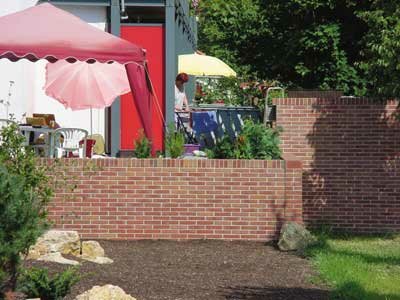 |
Converted housing with new terraces has brought greater residential quality (Picture: Lessingstrasse neighbourhood). (Source: Weeber + Partner, Stuttgart) |
Since the mid-1990s, constructional and urban structures in Südstadt, especially the housing stock, have changed considerably. In the course of redevelopment, demolition, and rehabilitation, it became clear that the panel-construction buildings offered a great deal of scope for adaptation and sustainable redesign to meet changing residential needs.
The close proximity of Südstadt to the adjacent Thuringian natural landscape area, as well as the many green and open spaces in the estate are very precious resources.
With the development of central traffic axes, (road/rail) access is to be improved to strengthen the attractiveness of Leinefelde as a location for industry.
3. Development Goals and Focal Areas of Action 
Since the mid-1990s, the political and administrative authorities, residents, and housing companies, with the support and aid of the Thuringian and federal governments, have been working to achieve far-reaching structural change in Leinefelde. The basis has been the urban framework plan for Südstadt adopted by the town council in 1995. The "Prospects Workshop" founded in the context of EXPO 2000, took up the strategic objectives of the framework plan, updating them in an integrative strategy concept covering social, economic, ecological and urban planning areas of action.
Selection as a model area for the "Socially Integrative City" programme gave further important stimulus to the social, participatory development of Leinefelde-Südstadt. The programme's goals and focus of action have fed into the integrative strategy concept of the Prospects Workshop, which is continually reviewed and updated.
In the "work and training" field, the main concern is to create jobs by ensuring a diversified and stable economic structure, which includes finding practicable substitute uses for industrial buildings and derelict sites in the industrial area. Specifically, this means encouraging the establishment of new industries in the existing industrial location and gradually achieving a broad range of sectors. It is particularly important to strengthen local and regional craft enterprises. Thanks to vocational re-education and training, many Südstadt residents have adapted to changed demands. Nevertheless, the labour market will not be able to provide work for everyone. It is all the more important to tap the endogenous resources of the district. Projects under the "Socially Integrative City" are also to address this problem. The concept for action provides for strengthening local services, promoting local industry by calling in local firms for building conversion, the establishment of a start-up centre, vocational training exchanges, and the development of swap shops.
The future of Südstadt depends essentially on offering young Leinefelders a perspective. The conversion of a school into a vocational training centre now offers young people the opportunity of obtaining training locally. The creation of a still denser network between industry, county, employment office, schools, and municipality is hoped to retain young people in Südstadt. The issue-specific conference in the context of the model programme was dominated by this issue.
In the field of "housing and the residential environment," Südstadt still has to take many a hurdle before it can become a lively and socially stable place to live. Structural shortcomings and the difficult personal circumstances of many residents cannot be remedied overnight. Constructional and urban planning changes have, however, already made a major contribution towards improving dwelling quality in Südstadt. Redevelopment and demolition, especially in the southern part of the district will lower residential density. Converted flats with new layouts offer greater dwelling quality and are in high demand. All these changes are supported by many residents and taken as positive signs for the future, even if some parts of Südstadt have had to become building sites again. The extensive demolition and redevelopment measures require good removal management. The municipal housing company WWL has developed exemplary solutions in recent years.
The dwelling environment is visibly changing, particular weight being placed on as wide a range of uses as possible, and greater differentiation into private, public, and half-public spaces. Public parking is gradually being reorganised, the central system of pathways is being extended, and courtyards remodelled. Luna Park has been built in the central area of Südstadt, offering a wide range of recreational, sports, and social amenities. Residents participate in various ways in improving the residential environment, for example in cultivating front gardens, in planning, or in the "Barrier-Free Town" working group.
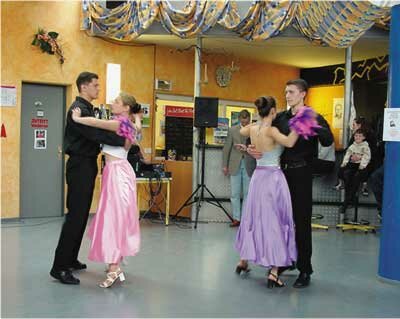 |
The broad spectrum of activities offered by the Youth Centre ranges from dancing and computer courses to outdoor play and sports. (Source: Weeber + Partner, Stuttgart) |
The high development and design quality in converted and new areas has brought many international visitors to Südstadt, enhancing the image of the district.
In the "social life and infrastructure" field, it has been of considerable value that a large part of the local population has been long established in Südstadt. Many social contacts and ties have developed. With a great deal of commitment and personal initiative, they help shape district life in many different ways; they are the "social capital" of Südstadt.
Outmigration and the arrival of new residents - many of them ethnic Germans from eastern Europe ("Aussiedler") have changed immediate neighbourhoods and life in the community, and provoked greater conflict. Particular help is needed for people in difficult personal circumstances. Various organisations already offer advice, aid, and support. The district management, in particular, must further the effectiveness of these facilities and to help in coordination and in directing helping hands to where they are needed most.
Schools and day-care nurseries play an important role in the development of Südstadt. Most of these buildings, including the attached open spaces, have been repaired and modernised in recent years. School children, teachers, and parents have been involved in various projects, for example to remodel school grounds and the computer project on virtual district development. These resources must be further strengthened.
4. Key Projects 
A new Youth Centre has been built in Südstadt, which was opened in October 1999. The facility, together with outdoor areas, offers 1,000 square metres of space for a wide range of recreational activities. The children and young people from the district were closely consulted in the planning. Their ideas were particularly instrumental in the design of outdoor play, sport, and sojourn facilities. The outdoor facilities were supported by the "Socially Integrative City" programme.
The centre has striking architecture and has been built in accordance with ecological principles. It is a round construction set into a natural slope, with a transparent glass façade on the south side and a solar energy array in the cupola. For energy-saving purposes, Energie-Spar-Union, a Leinefelde firm, has developed innovative solutions. Recycled concrete elements from the redevelopment of Leinefelde large-slab construction buildings have been used for outdoor amenities.
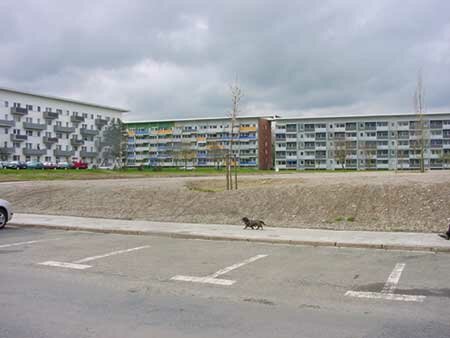 |
A Japanese garden is being laid out on a demolition site near the Tenants' Centre. (Source: Weeber + Partner, Stuttgart; Drawing: Prof. Kawamura) |
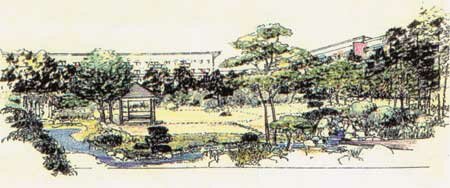 |
The Youth Centre is networked with other facilities in the district. It adjoins the new Luna Park, where various sports facilities are located, complementing those of the centre. The model project "Together" operates from the Youth Centre. It aims to support the integration of ethnic German immigrants and is being promoted in the context of the Federal Ministry for Family, Senior Citizens, Women and Youth programme platform "Development and Opportunities for Young People in Deprived Areas" (E & C).
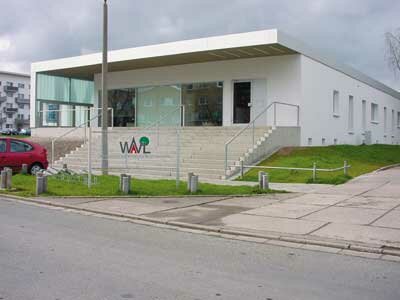 |
The new tenants' centre in the Hahn-/Hertzstraße quarter offers more service, sufficient room, and opportunities for socializing. (Source: Weeber + Partner, Stuttgart) |
The Tenants' Bureau with the Tenants' Centre aims to improve service for tenants and to promote neighbourly life. It has been installed in a panel-construction building scaled-down from five to two storeys. An adjoining second residential block was completely demolished. This has reduced the hitherto very high density of development in the area.
The office of the housing company Wohnungsbau- und Verwaltungs GmbH (WVL) has moved to this central location and is thus more accessible for tenants. Further services are to be made available here in collaboration with the municipal Citizens' Bureau.
The Tenants' Centre, which has a separate entrance, is another important component of the facility. It is multifunctional and suitable for a wide range of events as well as for private celebrations. It is much in demand.The neighbourhood management aims to develop the Tenants' Centre still more strongly, making it into a focus of district life.
On a demolition site near the Tenants' Centre a Japanese garden is currently being laid out. The idea was born during a visit to Leinefelde from a delegation of Japanese architects and civil engineers in late 2000. The foundation stone was laid in autumn 2001, and the garden is expected to be completed in May 2002. The project is being sponsored by the Free State of Thuringia and the "Commemorative Association for the Japan World Exposition (1979)," which supports projects worldwide for the promotion of Japanese culture. The association has contributed Euro 128,000.
The area covers 2,400 square metres. A stream, a hill planted with shrubs, typical Japanese planting arrangements, and a pavilion are important design elements. The Japanese garden is intended as a visual attraction, a place for people to meet and communicate. Events are planned for the garden in collaboration with the Tenants' Centre to introduce the public to Japanese culture in an entertaining and sociable manner. Tea ceremonies, ikebana, Japanese cooking evenings, lectures on health, and bonsai exhibitions are envisaged. The district managment is initiating and organising these events jointly with interested residents and institutions from the district.
The Social Centre is one of the most important projects in the "Socially Integrative City" programme currently planned for Leinefeld. A disused day nursery is to be converted to house various advisory and aid services. The local senior citizens' club is also to be accommodated here.
Also in the planning phase is the Women's Residential and Start-Up Centre. For historical reasons, Südstadt is very much a women's district. The staff and users of the women's centre developed the idea of converting a vacant residential building. The upper storeys will accommodate communal housing. The ground floor will provide office and industrial/commercial space for start-up businesses and premises for the centre. Negotiations are currently being held on the location for the project.
5. Organisation and Management 
The initiative to apply for inclusion in the "Socially Integrative City" programme came from the Leinefelde municipality. Experience had already been gathered in current projects, especially as a decentralised location for EXPO 2000. The organisational forms and control instruments tried out then have proved their worth and provide the framework for planning and implementation of projects under the "Socially Integrative City" programme.
Programme implementation is under the overall control of the mayor of Leinefelde. He chairs the regular coordination meetings between functional units in urban planning and social affairs, the district management, and the "local programme support" team on the status of projects and planning.
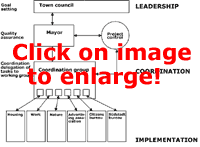 |
Organisation of programme implementation in Leinefelde. (Source: Stadt Leinefelde) |
For a year now, the district management has been operating under the aegis of a planning office. The district manager has had experience in preceding projects. The District Bureau set up in the context of the EXPO project and the project "Eco-Social Improvement of Built-Up Residential Areas" provided residents with an information and contact facility, and is now continuing operations as the local office of the district management, but with broader substantive scope.
An important organisational form for the conception and implementation of goals and measures fort the "Socially Integrative City" programme is the Social Round Table chaired by the mayor. It is composed of town councillors, representatives of social and cultural associations and groups, churches, welfare institutions, housing companies, and the district management. The "Social Round Table" is flanked by working groups (children and youth, women, barrier-free town, work and employment).
6. Activation, Participation, and Public Relations 
A central task of the district management is to integrate residents actively in all projects and to strengthen their potential for self-help. It is not always easier to reach residents. Depending on the issue and form of participation, the response has differed widely. Various forms and methods have been used for resident activation and participation, depending on, among other things, the status of work in process. In the initial phase, different modes of planning discussion were held as well as district inspections. As work proceeded, project-related events and activities came more to the fore, e.g. participation by residents in specific dwelling environment improvement measures, swap shops, cultural events. Th latter forms of participation, in particular, have proved their worth because they address the immediate needs of residents, have a direct impact, and, what is more, are enjoyable. This is apparent in the strong interest shown by residents in the Japanese garden and associated events.
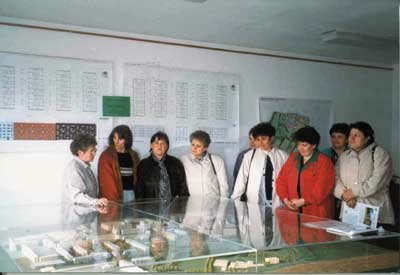 |
In the District Bureau, residents can obtain information and put forward ideas on future development. (Source: Leinefelde Municipality) |
What has also proved its worth in this connection is the contingent fund to the amount of Euro 5,000 which the district management can call on rapidly and unbureaucratically to back participatory activities that encourage engagement or to support resident projects.
Important for reaching local residents is the smooth operation of district networks, because they have a multiplication effect. An important precondition has been established with the "Social Round Table," which brings together all local social infrastructure institutions and organisations. This network has turned out to be particularly useful in youth work. Participation by children and young people in planning the Youth Centre, a prospects workshop, a training exchange, a children and youth art competition, the active involvement of children and young people in the intercultural week staged by Eichsfeld county were made possible largely through the participation and cooperation of district youth institutions, schools, and day care nurseries.
 |
The Prospects Workshop with children and young people in the context of the "Socially Integrative City" programme (spring 2001). Discussions focused on life in Südstadt, school life, the housing situation, and vocational training opportunities. (Source: Weeber + Partner, Stuttgart) |
Indispensable for informing residents and gaining their cooperation is the district newspaper "ZukunfstWerkStadt Leinefelde," which has been appearing since 1998. It has become firmly established in the district and appears every two to three months. The municipality pays printing costs.
In order to take stock with residents of what has so far been achieved, to plan further projects, and encourage continued engagement, the district management conducted an activating survey in Südstadt with the support of the municipality in which 700 households participated. This favourable response was certainly helped by the comprehensive public relations accompanying the project. Information was given in the local press, a report was broadcast on the "Open Channel" with the mayor and members of the district management staff. Not least of all, attractive prizes to be won by respondents increased popular interest.
7. Conclusion: From Industrial Settlement to Living Town 
Leinefelde-Südstadt is on the way to becoming a lively and sustainable district. Numerous projects have been implemented at a high level of quality, markedly improving the quality of housing and life for the population. The image of the district has begun to change.
Decisive for this success has been the committed, guiding action of the municipality on the basis of the common integrative strategy concept for Südstadt. Cooperation between actors has made it increasingly possible to bundle investment and non-investment resources at the municipal level. Federal and state support programmes, in particular, have been coordinated with the aid of the Thuringian government, and since 1993 support in the amount of over Euro 7,000,000 has been made available. Under the "Socially Integrative City" programme, the federal government has provided about Euro 1.3 million and the state government Euro 2.2 million for the planning and implementation of building and social measures in Südstadt.
However, the changes that have so far been achieved have shown the dimensions of the challenge of attaining a sustainable balance between housing and employment. More is needed than mere time: stable structural policy conditions are required, and the continued support and backing of the federal and state governments. The (new) programme Urban Renewal East offers an opportunity for continued progress in the structural change initiated with the residents of Leinefelde in the sense of socially integrative urban development.
Im Auftrag des BMVBS vertreten durch das BBR. Zuletzt geändert am 25.05.2005